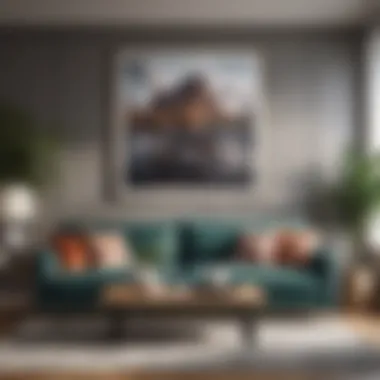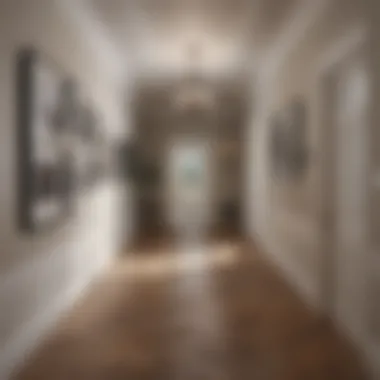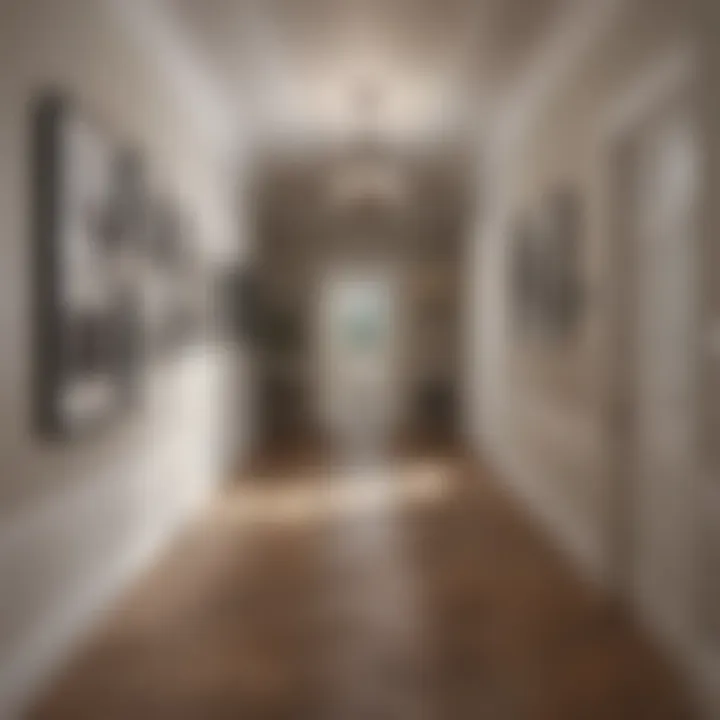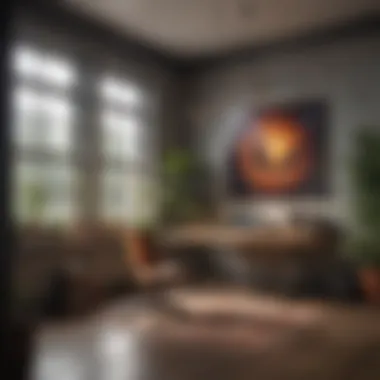Techniques for Hanging Large Pictures Effectively


Intro
Hanging a large picture is more than just a simple act of affixing it to a wall. It’s about creating a statement. It’s about harmonizing aesthetics, emotional resonance, and the functionality of a space. Whether you’re a homeowner eager to breathe life into your living room or an interior design aficionado seeking to blend art with architecture, understanding the nuances behind this process is essential.
Art has the potential to transform a blank wall into a captivating focal point, drawing attention and admiration. However, without the right approach and techniques, even the most magnificent pieces can feel misplaced or overwhelmed. This guide focuses on practical methods for hanging large pictures while considering important factors like spacing and thematic resonance.
From ensuring the artwork complements your home’s interior design to factoring in the psychological impact of art placement, each consideration plays a crucial role in creating a visually pleasing environment. You’ll also find insights into various mounting techniques that can enhance the stability and appearance of your chosen artwork.
As we dig deeper into this comprehensive guide, you'll discover how to integrate art seamlessly into your living spaces, making each piece a conversation starter. Let's dive into the first section, where we explore unique homes and their architectural highlights that inspire our choices.
Featured Homes
Architectural Highlights
In the world of real estate, standing out often means showcasing unique architectural elements that add character and depth to a home. Consider a space where high ceilings meet expansive walls—an ideal canvas for large-scale artworks.
- Open Concept Designs: These layouts allow for fluidity, encouraging the use of oversized pictures to guide the viewer’s eye throughout the space. Think about a large, bold painting positioned over a fireplace in a sprawling living room.
- Vaulted Ceilings: High ceilings can make even smaller pieces feel dwarfed. Large art pieces can establish a sense of grandeur and enhance the scale of the room.
- Statement Walls: Accent walls painted in bold colors or textured finishes can bring a picture to life, making it pop against its backdrop.
Each of these highlights presents an opportunity to choose artwork that not only fits the space but elevates it—turning any wall into an art gallery.
Interior Design Themes
Interior design themes dictate the kind of artwork that will be most effective in a particular space. Thematic coherence can create a sense of harmony, ultimately leading to a more inviting atmosphere.
- Minimalism: In a minimalist setting, selecting one striking image can create an anchor point. It's about letting the art speak for itself without distraction.
- Eclectic Mix: For those who enjoy a bit of everything—mixing styles, colors, and eras—a large picture that encapsulates various design elements can tie the room together.
- Traditional vs. Contemporary: The choice between classic landscapes or modern abstract pieces can significantly affect the room’s ambiance and intended message.
Understanding these themes is crucial in deciding which large picture will resonate most with the overall décor.
Art placement can shift the emotional tone of a room. Always consider how a picture makes you feel and the vibe you wish to convey.
The journey of hanging large pictures continues as we focus on practical techniques and considerations that ensure optimal placement and visual impact.
Understanding the Importance of Art Placement
Hanging artwork isn’t just about sticking a nail in the wall and calling it a day. The placement of art within a living space can transform not just the aesthetics of a room but also influence the emotions and thoughts of those who inhabit it. Art has an uncanny ability to speak, to provoke, and to inspire, and where it sits can either amplify its message or stifle it.
One primary reason for this significance lies in the psychological impact of art. Paintings, photographs, or any large pieces can evoke feelings ranging from tranquility to excitement, depending on their colors and themes. When thoughtfully placed, art can create a calming retreat in a chaotic lifestyle. For instance, a serene landscape hung in a bedroom can invite peaceful slumbers while vibrant, energetic pieces in a workspace can spark creativity and productivity. This is not a mere coincidence; it’s the subliminal conversation art has with your daily life.
Moreover, the visual balance in interior design plays a pivotal role in establishing an inviting atmosphere. It's all about creating harmony within the elements of a space. Placing large artwork strategically can balance heavy furniture or vast empty walls, serving as an anchor in the design. A sprawling abstract piece can counteract bulkiness in heavy furniture, providing a sense of flow. When art complements the other elements in a room, the entire space starts to breathe and tells a story that resonates emotionally with anyone who enters.
"A well-placed artwork can change everything; it can set the mood and evoke memories you didn't even know were there."
A critical element, if not the most crucial consideration, is how art placement affects the perception of size and shape within a room. For example, a large picture hung high can draw the eye upward, creating a sense of height and spaciousness. In contrast, when placed lower, it can make a large room feel more intimate. It's clear that understanding the importance of art placement goes beyond mere aesthetics; it encompasses a delicate interplay of psychology, balance, and perception. Art is more than decoration; it's a statement and an experience all on its own.
Selecting the Right Space for Your Picture
Selecting the appropriate space for a large picture can be akin to finding the right fitting jacket; it needs to suit the space’s size and purpose while complementing the overall decor. The significance of this step cannot be overstated. A well-placed artwork creates a focal point, drawing the eye and communicating a mood or feeling. Moreover, the positioning of art can influence how a room is perceived, enhancing its dimensions or altering its atmosphere. This section delves into important factors to consider when choosing a spot for your artistic centerpiece.
Evaluating Wall Size and Proportions
When it comes to hanging large pictures, sizing is everything. Wall size and proportions dictate whether an artwork will feel oppressive or merely harmonious. Visually, a wall that is too small can make a large picture seem out of place, almost like a lone cloud in a clear sky.
To avoid this, take a moment to measure the designated wall using a tape measure. Consider the dimensions of your artwork versus the wall space it will inhabit. Often, one may find that a 70-80% rule works wonders: the picture should occupy this percentage of the available wall space. This approach allows art to breathe while creating a balanced composition within the room.
Visual Tip: Consider using painter’s tape to outline the dimensions of the artwork on the wall. This visualization can greatly assist in gauging the effect of the piece before actually hanging it.
Considering Room Functionality
Another key element in selecting the right space for your picture is room functionality. Different areas of the house serve varied purposes, and art should reflect or enhance that atmosphere. For instance, a lively, vibrant piece might animate an informal living room or play area, while a tranquil, muted image may suit the quietude of a bedroom.


Considering foot traffic and furniture placement is also crucial. High-traffic areas, like hallways or family rooms, will benefit from art hung at eye level, making it easily viewable without obstruction. On the flip side, spaces designated for relaxation may allow for larger or more eclectic displays, enabling introspection and comfort.
- Think about the emotion you want to evoke in each room.
- Ensure the artwork doesn’t clash with other decorative elements.
- Consider how the piece interacts with furniture arrangement.
Lighting Conditions for Optimal Display
Lighting is the unsung hero of art display. While a piece may be visually stunning, poor lighting can diminish its charm. Understanding natural and artificial lighting conditions can lead you to choose an ideal spot for your large picture.
First, assess the natural light that filters into the space throughout the day. Art that is hung in direct sunlight may fade over time, while a dimly lit corner might rob a vibrant piece of its allure. Aim to position your artwork in a manner that it catches light without being overexposed.
Moreover, supplemental lighting, such as spotlights or picture lights, can accentuate features of the artwork and create ambiance in the room. Ensure that any lighting used provides even illumination, avoiding harsh shadows which could detract from the viewing experience.
"The right light can transform a good piece of art into a great centerpiece, illuminating its story and depth."
Measuring and Preparing the Wall
Getting the wall ready for a large picture is like prepping for a big show. It’s all about making sure you’ve got the right backdrop before bringing out the star of the room. Measuring and preparing the wall not only ensures that the artwork fits nicely, but also makes a significant difference in the overall aesthetic and harmony of the space. An accurate measurement can save headaches down the line, avoiding the need for constant adjustments or worse, damaging the wall when attempting to rehang.
Tools Required for Measurement
Having the right tools on hand can make your measuring task smoother than a hot knife through butter. Here’s a rundown of what you’ll need:
- Measuring Tape: A sturdy one, ideally at least 25 feet long, will help you cover most walls.
- Level: This keeps your picture straight. No one likes a crooked piece of art.
- Pencil or Marker: Use it to mark spots lightly on the wall. Make sure it’s one that’s easy to erase later.
- Straight Edge or Ruler: This comes in handy for drawing precise lines between your marks.
- Step Stool or Ladder: For those hard-to-reach areas high up on the wall.
These tools make the job much easier, saving you the frustration of guesswork. Like they say, measure twice, cut once! Only in this case, it’s more about measuring twice so you don’t need to drill five times.
Marking the Desired Height
Once you've got your measurements sorted, it’s time to decide where exactly you want to hang your art. Finding the right height to mount a large picture can significantly affect how it feels in the room. The general rule of thumb is to hang art so that its center is about 57 to 60 inches from the floor, which aligns closely with the average eye level. However, personal preference comes into play, especially if you’ve got unique furniture setups or design styles in mind.
When marking the wall:
- Stand Back: Take a step back and visualize. Standing too close can skew your perspective.
- Use a Level or Measuring Tape: Decide the desired height and apply your level to avoid any lopsided views.
- Mark the Spot: Get a light pencil mark on the wall where the top of the picture will be.
- Consider Surroundings: Look at furniture and other décor around the area. An art piece well hung should complement its environment, not clash with it.
In the end, getting the height right isn’t just about aesthetics; it’s about creating a pleasing and inviting environment that draws the eye and enhances the space's ambiance. After all, art is not just to be seen; it’s to be savored.
Choosing the Right Hanging Hardware
Choosing appropriate hanging hardware plays a pivotal role in the successful display of large pictures. It's not just about aesthetics; it’s also about ensuring safety, durability, and long-term satisfaction. The right hardware can mean the difference between a perfectly hung artwork and a disaster waiting to happen.
First off, consider what kind of wall you’re dealing with. For example, drywall requires specific types of anchors, while brick walls call for a solid hanging system that can withstand more weight and provide stability. A lot of folks may overlook this initial step, thinking any hardware will suffice. But picking the wrong piece could lead to an artwork falling, potentially damaging both the piece and the wall, not to mention the sheer frustration of redoing the entire setup.
In addition, it’s essential to pay heed to the weight and size of the picture you intend to hang. Larger items necessitate robust hardware options that can bear the load without buckling. Plus, the right choice could add a subtle touch to the overall look of your space.
Types of Hangars Available
When it comes to hanging hardware, variety reigns supreme. Below are some popular types of hangars you might consider:
- D-Rings: These are metal loops that attach to the back of the frame, offering a sturdy method for hanging. They’re particularly useful for heavier pictures.
- Picture Wire: This consists of thin wire attached to D-rings on either side of the frame. It allows for flexible positioning and is excellent for adjusting the height.
- Wall Hooks and Adhesive Strips: Ideal for lighter frames, these can be particularly useful in rented spaces where drilling holes may not be an option.
- Cleat Hangers: Two interlocking pieces work together to secure the picture firmly against the wall. They distribute weight evenly, making them great for larger artworks.
"Selecting the right type of hangar can substantially enhance the viewing experience while preserving the integrity of both artwork and wall."
Choosing the right hardware isn't simply a matter of personal preference; it requires a clear understanding of each type's benefits and suitability for your particular piece of art.
Weight Considerations for Large Pictures
Weight is another crucial factor when selecting hanging hardware. Art pieces can vary significantly in weight depending on their materials and frame designs. For larger images, you must confirm that the hanging hardware can handle the load effectively.
- Underestimating Weight: Many homeowners often underestimate the weight of large pictures. A framed canvas can weigh more than expected when you factor in the glass or acrylic cover and stout frames.
- Safety First: If you plan to hang something hefty, aim to use hangars rated to support more than the weight of the artwork. This creates a buffer and adds more safety.
- Testing the Setup: Once hung, give a gentle tug to ensure that the picture feels secure. If it shifts, it might be time to reassess the setup and possibly opt for a heavier-duty solution.


By considering both the type of hanging hardware and the weight of your artwork, you create a foolproof method to display your large pictures smartly and safely. It’s all about combining practicality with artistry to make your space feel just right.
Techniques for Hanging a Large Picture
Hanging a large picture can be a daunting task, yet it’s a vital skill to master for enhancing your living space. The techniques involved in this process don’t just focus on the physical act of hanging but also consider the aesthetic and psychological elements at play. Getting it right can draw the eye, balance out a room, or even serve as a conversation starter. Moreover, the benefits of employing effective hanging techniques extend beyond just practical implications; they can truly transform the feel and functionality of a space.
Using the Two-Person Method
When you are dealing with sizable pieces of art, having a second set of hands is invaluable. The two-person method is often regarded as the best approach for such tasks due to its inherent safety and ease. To put it simply, this starts with one person holding the artwork up to the wall at the desired height while the other stands back to assess its placement from various angles. This allows for immediate feedback and adjustments, which is especially beneficial in finding what looks best in the space.
Moreover, you can avoid cumbersome mishaps such as dropping the piece or hanging it too high or low. In this method, the use of a secure mounting system should be emphasized, ensuring both pieces work together—artwork and wall. The collaboration can often lead to a more dynamic and enjoyable experience.
The Single-Person Approach
While having another person helps, there are times when you might be flying solo. In such cases, the single-person approach comes into play. One of the key things here is to first mark the height you intend to hang the picture, using a pencil or painter's tape to outline its position. This method allows you to step back and check your work frequently, adjusting as necessary without the interruption of a partner.
A great tip for this solo method is utilizing hooks that can accommodate multiple hanging options. This flexibility allows you to make shifts later without needing to start fresh.
Also, it might be swapped. If you're working on a large canvas, consider propping it against the wall or laying it flat on the floor. This gives you the freedom to play around with the layout and positioning without the tension of trying to hold something heavy while attempting to assess its placement.
Utilizing a Level and Measuring Tape
Precision is king when it comes to successfully hanging large pictures. Using a level and measuring tape are fundamental tools to ensure your artwork is straight and properly positioned. Start by measuring the distance from the floor to the center of the piece, then mark this on the wall.
This step ensures that the center of your artwork is eye-level, which generally creates a more pleasing visual experience. In addition, using a level ensures that the picture won’t have a tendency to tilt or lean once it’s hung up.
A good practice is to place the level on top of the frame once it's in position, adjusting until the bubble is centered. It might seem like a small detail, but doing these checks elevates the overall impression of the piece significantly.
"Proper Tools and Techniques not only prevent damage to your walls but also extend the lifespan of the artwork itself."
Creating a Gallery Wall with Large Pictures
Creating a gallery wall is like crafting a visual narrative that draws the eye and sparks conversation. When you hang large pictures together, you’re not just filling a wall; you’re creating a focal point that can bring a room to life. The significance of this section lies in understanding how a carefully arranged collection can elevate the aesthetic of a space and reflect personal taste. A well-executed gallery wall effectively combines disparate pieces into a harmonious ensemble, offering visual rhythm and inviting viewers to engage with the art in a thoughtful manner.
Several benefits emerge from this approach. First, gallery walls allow one to express individuality. They can encompass a range of styles and formats—from bold modern art to traditional landscapes—creating a rich tapestry that tells a story about the inhabitants of the home. Furthermore, this arrangement can maximize the impact of large pictures, ensuring they are not overwhelmed by the surrounding decor or furnishings. It’s also a practical solution for those with several favorite pieces, offering an elegant way to showcase them without sacrificing wall space.
Nonetheless, organizing a gallery wall takes consideration. Balancing the visual weight of each piece while maintaining a cohesive look challenges even seasoned decorators. Understanding spacing, alignment, and the overall aesthetic theme becomes fundamental. In the end, a thoughtfully curated gallery wall can transform any room into a sophisticated space that feels both lived-in and stylish.
Choosing an Aesthetic Theme
Before diving into the process of arranging a gallery wall, it’s vital to choose a cohesive aesthetic theme. Your aesthetic should reflect not only personal style but also fit the broader ambiance of the room. Whether it’s modern minimalism, vintage charm, or an eclectic mix, this foundational choice guides the entire project.
It begins with considering color palettes. If the wall decor harmonizes with the existing colors in the room, it can tie the look together beautifully. For instance, if a room boasts muted earth tones, selecting large pictures that echo those shades—perhaps through soft landscapes or abstract pieces—can create a seamless flow.
Additionally, it’s helpful to think about texture and materials. A mix of framed art, canvases, and even textiles can add depth. For those drawn to contemporary art, integrating sleek frames in monochrome schemes can enhance a modern vibe. Conversely, rustic wood frames could underscore a farmhouse aesthetic.
In some cases, it might be useful to sketch your ideas on paper or use digital tools to visualize the layout. This initial planning saves time and energy during the actual hanging process.
Arranging Pictures for Maximum Impact
Arranging pictures isn’t just an instinctual endeavor; it’s a strategic design process. Matching scale, orientation, and spacing ensures that large pictures contribute to the overall impact without feeling jumbled. Here are essential considerations:
- Focal Point: Identify which large picture will serve as the star of the wall. This can be a vibrant painting or a powerful photograph. Other pieces can then complement this focal point.
- Visual Flow: Consider how the viewer's eye will move across the wall. Arranging pictures in a balanced manner allows for easier visual navigation. For instance, grouping similar colors or styles together can create a spontaneous flow.
- Spacing: Don’t overlook the gaps between your pictures. Too much space can leave a wall looking sparse, while too little can clutter it. A general rule of thumb is to maintain a 2 to 4 inch gap between frames, but this can vary.
- Layering: For large pictures, consider layering smaller pieces around or over them. This sort of arrangement creates an intriguing depth and can highlight the larger works effectively.
One effective technique is to lay out your pictures on the floor before hammering any nails into the wall. This way, you can step back, assess the arrangement, and make adjustments until you’re satisfied. Finally, make sure to secure your pieces correctly—there’s nothing worse than watching a beloved artwork tumble from the wall!
"A gallery wall allows for artistic expression and gives each piece its stage in the larger narrative of the room."
In summation, creating a gallery wall involving large pictures isn’t just about aesthetics; it’s about creating an environment that’s personal, inviting, and intellectuall engaging. With the right theme and arrangement techniques, you can transform a plain wall into an extravagant manifestation of style.


Maintenance and Adjustments for Long-Term Placement
When it comes to hanging large pictures, it's vital to think beyond the initial placement. Maintenance and adjustments are essential for ensuring that the artworks continue to enhance the aesthetic of your space over time. Proper care not only protects your investment in art but also helps maintain a cohesive look in your home. A well-maintained art piece can elevate a room's appeal, while neglect can lead to disarray and deterioration.
Periodic Inspection of Hardware
One of the key aspects of maintaining art on your walls is keeping an eye on the hanging hardware. Over time, the weight of large pictures, along with shifting home environments (think of temperature changes, humidity, and even minor tremors), can put stress on the brackets, hooks, or nails. Here’s what you should regularly check:
- Tightness of screws and anchors: If they start loosening, it might be time to either re-secure or replace them.
- Condition of hooks or wires: If these seem frayed or worn, a change is necessary to avoid any accidents.
- Visibility of wall damage: Look for any paint chipping or marks from where the art was mounted. Not addressing these can lead to bigger issues.
Performing these checks every few months is ideal. You’d want to catch potential problems before they escalate—just like a stitch in time saves nine.
Re-evaluating Art Placement
Another vital element of long-term maintenance involves periodically re-evaluating the placement of your large pictures. While they may have fit perfectly into a room’s design scheme when you first hung them, over time, both artwork and surroundings can evolve. Ask yourself:
- Is the artwork still in harmony with the room's decor? Styles change, and what once looked great may become jarring if nearby items have been updated.
- Is the piece positioned well in terms of light exposure? Sunlight can fade colors or even damage certain materials over time. You might consider moving the piece if it’s now subject to harsh lighting.
- Does the emotional connection still hold? Art should inspire and resonate with you. If your feelings about a piece change or you find it no longer reflects your personality, then a change of place may be in order.
"The best place for art is where it speaks to you, every single day."
Keeping the dialogue open between you and your artwork can lead to a dynamic and fresh environment.
In summary, maintaining large pictures within your home isn’t just about their initial installation; it’s an ongoing commitment. Recognizing the nuances of hardware inspection and the importance of re-evaluation can sustain the vibrancy and appeal of your cherished pieces for years to come. By being proactive in your approach, you not only protect your investment but also create living spaces that reflect your evolving tastes and experiences.
Inspiration from Different Styles and Trends
When it comes to showcasing large art pieces, diving into various styles and trends can provide a fresh perspective. Art isn’t just about the piece itself; it’s about how it fits into the broader context of a space. Different styles offer a myriad of choices that not only elevate the aesthetic but also speak volumes about personal taste. Here is a closer look at three prominent styles: modern minimalism, eclectic combinations, and classic approaches.
Modern Minimalism
Modern minimalism emphasizes simplicity and a clean aesthetic. The philosophy often leans on the principle that less is indeed more. When selecting artwork for a minimalist setup, larger pieces can command attention while contributing to a serene atmosphere. Choosing a single expansive canvas can become a focal point against a stark white wall, effortlessly pulling the viewer's gaze.
Think about using neutral colors for the art, as they tend to harmonize with other elements in the room without causing visual chaos. Placing a lush green plant nearby can add a splattering of color without distracting from the main piece. This contrast enhances the minimalist feel, ensuring each item in the room has reason to be there. The idea here is to create a sense of tranquility, where the art complements rather than overwhelms.
Eclectic Combinations
Eclectic design is like a thick stew made of different tastes and textures, bringing various styles together to form a unique composition. Large pictures can serve as conversation starters when layered with numerous other pieces of art. This diversity enables individuals to express their personality through art.
In an eclectic arrangement, mixing various frame styles and colors is encouraged. A vibrant abstract piece can be placed alongside black-and-white photography, creating a dynamic visual interplay. When arranging these pieces, one thing to bear in mind is the overall color palette; while an eclectic style thrives on variety, a cohesive color scheme ensures that the overall composition does not feel disjointed.
"Art is not what you see, but what you make others see." – Edgar Degas
Classic and Timeless Approaches
Classic styles often evoke a sense of elegance and tradition. Large art pieces in a classic setup typically draw from historical influences, with rich colors and intricate details. Think of theraw beauty of landscapes or portraiture, which carry the weight of time and craftsmanship.
When curating these pieces, consider the scale of the wall. Large portraits framed in ornate gold or wooden frames make for compelling wall decor and add sophistication. This classic approach does not disregard modern elements but rather, incorporates them into a narrative that’s both aged and contemporary. Establish a balance between modern furniture and antiquated art for a ‘then and now’ feel, ensuring a seamless blend that feels both lived in and curated.
Understanding different styles and trends positions you to create spaces that are not only visually appealing but also reflect personal identity. Through modern minimalism, eclectic combinations, or classic approaches, the way you display large art pieces can transform a room into a work of art in itself.
Epilogue: Elevating Spaces with Large Art Pieces
Hanging large artworks isn't just about aesthetics; it plays a pivotal role in the atmosphere and functionality of living spaces. This guide sheds light on the intricacies involved in achieving this, emphasizing various techniques and considerations that can significantly enhance any area.
Selecting the right artwork that resonates with personal style or the overall theme of the home is paramount. It's like finding that missing piece in a puzzle—once it's in place, the entire room comes together in a way that feels both cohesive and inviting.
Furthermore, large art pieces can serve as conversation starters. Guests will invariably be drawn to such striking displays, offering a natural segue into engaging discussions. This connection is often personal, reflecting the owner's tastes and experiences, thereby fostering relationships through shared appreciation for art.
- Expressing Personality: Art pieces are often an extension of who we are, reflecting our experiences, beliefs, and tastes.
- Defining Space: Large pictures can help delineate different areas within an open-plan home, becoming a backdrop that provides clarity to the space.
- Enhancing Ambiance: Different styles or colors can change the mood of a room, whether it’s calming blues for relaxation or engaging reds for creativity.
When approached thoughtfully, hanging large pictures can dramatically transform both the physical space and the emotional resonance of the home. The right piece, in an appropriate place, with the proper hardware, will withstand time—both in style and physical integrity.
"Art is not what you see, but what you make others see." – Edgar Degas
Through the techniques outlined, from measuring to choosing the right hardware, along with maintenance advice, homeowners can ensure that their prized pieces remain a source of joy for years to come. The journey of integrating art is ongoing, with each placement prompting re-evaluation and fresh inspiration.
As we've explored, the art of hanging large pictures transcends mere decoration; it's a thoughtful process that leads to elevating spaces, creating environments rich in warmth, personality, and character. Embrace this journey, knowing that every piece hung tells a story, enhances life, and invites wonder into the everyday.







